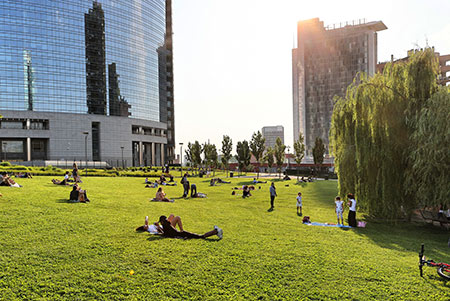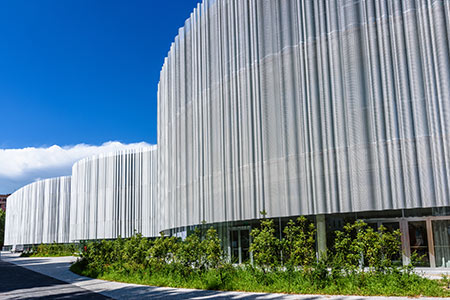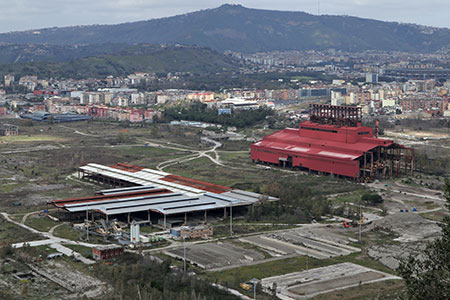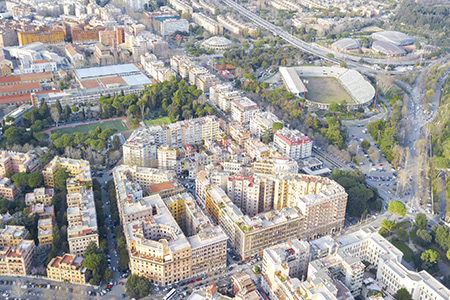The resources provided by the Recovery Fund are a great opportunity to support our cities in their transition towards the smart cities of the future, through the renewal of their real estate assets and the redevelopment of urban spaces throughout Italy.
This was confirmed by Silvia Rovere, President of Confindustria Assoimmobiliare, who stressed that the importance of these interventions in built-up areas is such that they must be guided at a national level: “Urban regeneration projects must be part of the National Recovery and Resilience Plan for two reasons: to respond in an effective way to the three macro-objectives of the Next Generation EU plan (green, digitalization and social inclusion) and to launch a sustainable development plan for Italian cities in order to make them more like smart cities”.

BAM - Biblioteca degli Alberi Milano is the result of the
first public-private partnership for the management
and cultural activation of a public park
In the context of major urban regeneration projects, public-private partnerships should play a leading role in stimulating economic recovery after a period of crisis such as the one we are currently experiencing, and in fostering a climate of confidence linked to investment plans.
Showing the Association’s analysis of real estate investments in recent years, Silvia Rovere points out that “what emerges is that urban regeneration projects generate a GDP multiplier effect of 1 to 3: for every euro invested, they generate three euros of added value”.
The transformation of urban centers can therefore trigger a series of positive effects for the entire Italian economic system, involving many SMEs and making a substantial contribution to increasing employment levels: “urban development projects can represent an enormous stimulus not only for the construction sector, but to support the relaunch of entire Made in Italy industrial sectors, which are essential for GDP growth: from the materials industry to plant engineering, from domotics to ceramics, passing through wood-furnishing and the entire world of professions and related services”.
In this process of transformation of our cities, a key aspect to invest in is digitalization, both at an administrative level, to make processes faster, more transparent and more efficient, and in terms of modernizing public services and adopting technological tools to analyze data and meet citizens’ needs.
Technology dissemination is one of the three drivers of smart city development, along with social inclusion and sustainability. The latter, in particular, has become so important that it was also highlighted by the Draghi government through the creation of a ministry dedicated to Ecological Transition.
“Real estate and property are an integral part of this process. The European Commission itself reminded us of this in its Renovation Wave strategy, highlighting that 36% of Europe’s CO2 emissions are generated by buildings. This figure rises to over 70% for particulate matter: action is needed to improve the energy performance of Italy’s building stock”.
See also: Cities, capital and skills for a sustainable recovery

Bocconi University’s new campus in Milan with
its student residences
Sustainability and digitalization become in turn a prerequisite for reaching the objective of the third guideline of transition: “a plan of interventions to improve and modernize our real estate assets would allow us to make new investments in technology, thus accelerating our country’s digitalization programme and offering an effective response to the objective of social inclusion. Through the regeneration of the most neglected areas of our cities, projects will be implemented that respond to new needs, such as the rental of energy class A buildings at affordable prices, and the increase of social and student housing.
In this respect, it is clear that the pandemic is bolstering a trend that was already underway: the rethinking of services according to a logic of proximity, in a context in which many Italian cities are still characterized by a distinction of urban areas by purpose of use. As Silvia Rovere states, “the reference model for the future must be a polycentric city, made up of mixed-use neighborhoods”.
This is a course already marked out by Milan which, over the years, is increasingly becoming a model to be emulated, including for smaller centers: “there is undoubtedly an issue of lower liquidity in the secondary markets, to be compensated for by an appropriate price differential. But in order to make secondary destinations appealing, the secret is to propose solutions that represent a clear opportunity because they respond to a real need, such as the construction of a student facility in a city with a university vocation”.
See also: The role of universities in urban innovation
In the context of smart city requalification, Assoimmobiliare has put forward 25 proposals to the Government, including specific initiatives such as the lifting of the obligation to pay property tax (IMU) on properties undergoing regeneration or renovation work, and the creation of a public guarantee fund to facilitate access to financing for investments in energy requalification work on buildings.

Naples, ex industrial area
“Among the proposals we have put forward, I think we can expect the quickest results from interventions designed to encourage investment in urban regeneration projects, with financial aid for the renewal of abandoned and run-down areas. We must concentrate on a joint effort to mobilize all the necessary resources, starting with tax incentives and, in this specific case, to attract the capital of foreign investors, taking appropriate action to make the legislative and fiscal instruments more recognizable and easier to use.
Urban regeneration and the relaunch of the national economy therefore go hand in hand, and have a common goal: people’s well-being. The pandemic has not only changed our habits, it has forced us to reflect, and has shown the importance of consolidating certain emerging trends in the real estate and urban redevelopment sectors.
It is only by acting today, through substantial measures that enhance the value of development vectors such as sustainability and digitalization, that we will be able to say in the coming years that we have seized a unique opportunity and chance, and that we will be able to provide future generations with better quality of life in urban contexts that are truly tailored to human needs.



